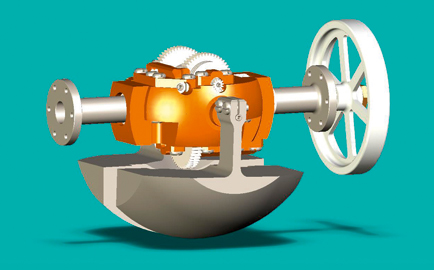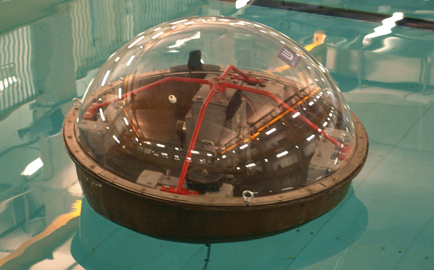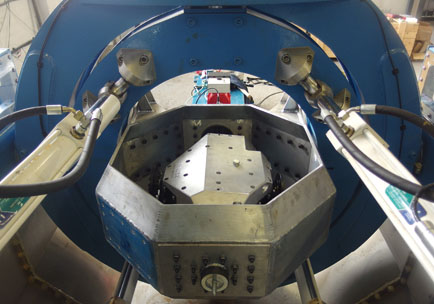As anyone who has been on a boat knows, sailing vessels do not just move smoothly through the water – they also pitch up and down and roll from side to side. The same is true of the buoys that demarcate the navigable channels into harbours.
In fact, the sea is full of such motion. Although it is chaotic, it has been identified as a potential source of limitless, effectively carbon-free energy if a means could be found to convert it reliably and predictably into electric power. The notion of doing so has become increasingly popular as official policies have favoured the development of renewable energy sources.
But if the ambition itself is not new, one of the latest ideas for achieving it is, as it involves an unprecedented means of harnessing power. The device is called the Whatever Input to Torsion Transfer transmission system, or WITT, and is claimed to be the first of its kind with the potential to translate all six possible degrees of motion – up and down, backwards and forwards, rotation about an axis – into a single output that can drive a generator to produce electricity.
Essentially, the system comprises two pendulums that react to external movement to drive a flywheel and gearbox, that in turn drive a conventional generator. As well as that fundamental versatility, the device also has other interesting characteristics.

A flywheel and gearbox are driven by two pendulums reacting to external motion
One is that it is potentially scaleable from something small enough to be worn to harness energy from human or animal movement – indeed, the first prototype was a hand-held unit – to a device large enough to generate grid power.
Another is that all the working parts can be sealed inside a robust housing pierced only by the wires needed to carry the electric current they generate, thus making the device both resilient to damage from external forces and neutral in terms of possible degradation of the local environment.
A third is that it should be able to produce power across the widest possible range of excitation, so a grid-scale device at sea would not have to be shut down in storm conditions – as is usually the case, for instance, with a wind turbine.
A fourth is flexibility of application. In conditions of continuous excitation, it could generate immediately usable power. But where excitation is more intermittent, it could charge a battery from which a steady stream of electricity could be drawn later.
As with many such ideas, the WITT originated with one person, who made the first working example as a solo project. Martin Wickett, a civil engineer by training based in the South West, built the initial device five years ago from off-the-shelf components.
But now the concept has gathered sufficient momentum to be the subject of an ongoing £300,000 development project – £190,000 of that from the UK’s Technology Strategy Board (TSB). The work aims to test the latest prototype to develop a ‘look-up’ table that will enable accurate prediction of the amount of power likely to be generated by specific sizes of the device in particular circumstances.
The project involves several industrial and academic partner organisations – WITT Energy, the small company founded by Wickett and his wife Mairi to bring the device to the market; shipyard A&P Falmouth, which is leading the project; specialist vehicle builder Supacat, which designed and built the latest prototype; Plymouth University, which performed tank testing of an earlier version; and the University of Exeter, which is carrying out the latest batch of tests on a hydraulic rig it operates called the Dynamic Marine Component Test facility (DMac).

Making waves: Plymouth University tested an earlier version
On the genesis of the device, Martin Wickett says he had been thinking for some time before he built the first prototype about ways of converting “bidirectional movement to rotation”. The concept has been developed to enable the exploitation of the six possible degrees of motion depending on the orientation of the device – in technical terms it involves “rotation around and up to three orthogonal axes”, he says. There was no single ‘Eureka moment’. He realised the device offered a novel capability, and this was gradually confirmed during early practical testing, which led to the first UK patent application in 2009.
Three prototypes preceded the present round of testing, says Wickett. The first was a ‘proof of concept’ device, but the other two were subjected to intensive testing.

Rig research: The University of Exeter is carrying out the latest tests
Of these latter two prototypes, one was a ‘boardroom demonstrator’ with a pendulum weighing just 0.9kg. Despite its small size, it was at one point linked to a small generator that enabled it to validate the concept by producing 4W of electricity to power a large neon lamp.
The other prototype was a much larger device, with a pendulum weighing 20kg, that underwent the water-tank testing at Plymouth University. It was also assessed by Strathclyde University, which produced two analyses of the technical and commercial potential of the concept. This version was not used to generate any power, but its reaction to waves as small as 10cm high makes Wickett confident it could power a generator to produce “several hundred” watts.
Now, though, the latest version of the device will take the development programme even further. It will move well beyond proof of concept to demonstrate proof of operation, mainly on the grounds that it has been designed and built to the level of a pre-production prototype, says Wickett. All of its components, for instance, are appropriately machined, with no rapid prototyped parts used as in previous versions.
The device’s scope is confirmed by Sean Limbrick, head of design for Supacat, best known for making the armoured logistical vehicles used by the armed forces, such as the Jackal and Coyote. Supacat’s skills in designing and building rugged machines, gained through its vehicle work, fit well with renewable energy, he says. The company encountered the WITT last year, was immediately struck by its potential, and needed little persuasion to join the project team bidding for the TSB support.
The design and assembly of the device took only a couple of months at the end of last year, says Limbrick. Several factors helped in achieving that speed of progress.
One was that Supacat did not have to ‘reinvent’ the device, but could follow the basic layout that previous versions had established. Another was that it could source several key components, such as gears and bearings, ‘off-the-shelf’. A third was that the device makes no demands for exotic materials, with steel and aluminium predominating. However, Supacat did rigorously analyse the design to minimise the final cost of the device, and also designed the shafts and casing, says Limbrick.
The latest version of the device can be fitted with pendulums in the range 20-50kg and is contained within a strong external casing. This casing helps to ensure maintenance-free operation. The transmission contains free oil, which will continuously lubricate its moving parts because of the excitation of the device as a whole. In real-life applications, autonomous operation for extended periods – perhaps five to 10 years – might well be required.
What was once merely an intriguing idea is now being taken seriously as a practical engineering proposition. Last October, the device won the 2013 Gulfstream Navigator Award – worth $100,000 – from the Ocean Exchange organisation, a venture that recognises environmentally friendly innovation with a potential for
global application.
The WITT’s attraction as a commercial opportunity is confirmed by Paul Weston, renewable energy technical manager with A&P Falmouth. As with Limbrick, Weston was immediately impressed by the potential of the device. It was obviously unique, he says, and that aspect clicked with the company. A&P has shown the device to ship operators and they, too, have responded positively to its potential, he adds. He believes the device could be in use in ships, as a means of generating electric power, in as little as two years.
Where else the WITT might be applied remains to be seen. Its combination of scaleability and reliability means there are few limits on its applicability, Wickett believes. Wherever there is a free source of energy that manifests itself in chaotic form, then the device holds out the possibility of converting this energy into usable, useful electric power.